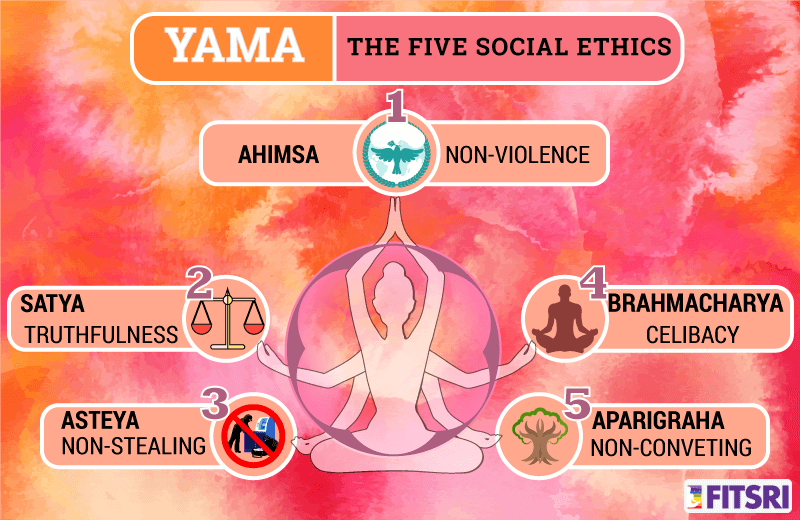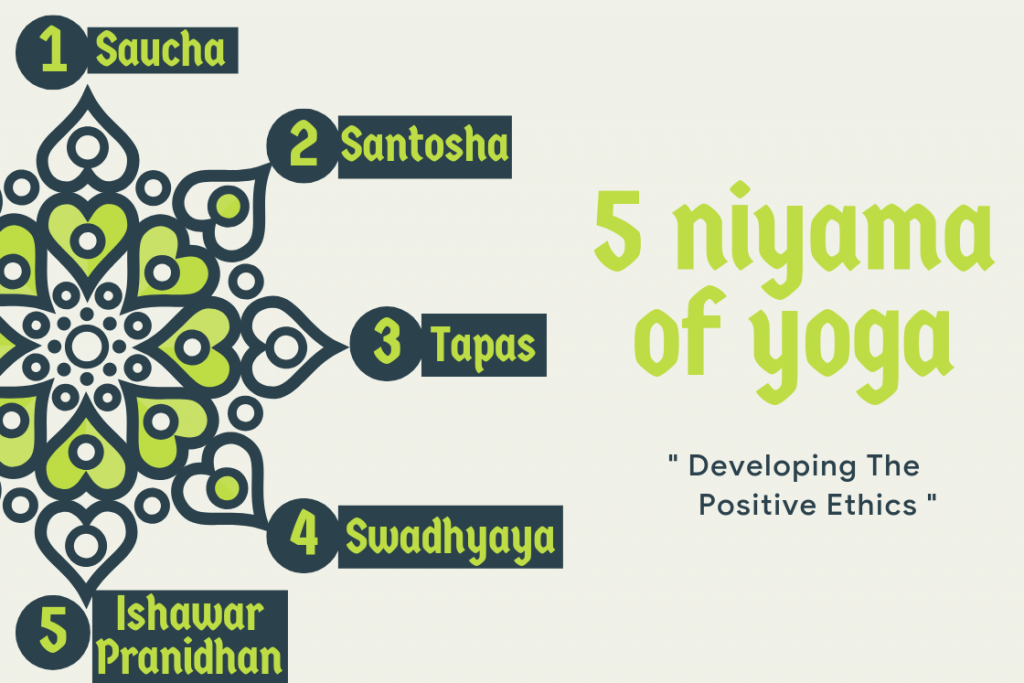- 5 Yamas & Niyamas
- Connecting two
- The Yamas
- Ahimsa
- Satya
- Asteya
- Brahmacharya
- Aparigraha
- The Niyamas
- Shaucha
- Santosha
- Tapas
- Svadhyaya
- Isvarapranidhana

A particular philosophy of yoga is interpreted as, the very world that binds us to suffering, if analysed properly, can guide us to spiritual and intellectual liberation. Our daily experiences which we hold accountable for misery can produce profoundly liberating universal insights. If only we can appropriately reorient ourselves to them.
The eight limbs of yoga give the perspective required to reorient ourselves in such an appropriate way. The sage Patanjali’s compilation, The Yoga Sutras, in 400 CE was the first to systematically introduce the eight limbs system.
According to Patanjali’s work, Yoga is a discipline that leads to an awakening of self to unite with the oneness of the universe. If you think of the discipline yoga as a wheel, then the eight limbs are its eight spokes, that all support each other and together make the wheel functional.
The eight limbs of yoga are Yama (Self-restraint,) Niyama (self-purification,) Asana (posture,) Pranayama (Controlled breathing,) Pratyahara ( sense withdrawal,) Dharana (one point concentration,) Dhyana (meditation), and Samadhi (absolute absorption).
What are the 5 Yamas and Niyamas?
The 5 Yamas and Niyamas are the first two of eight limbs that combinedly make 10 ethical principles of yoga and must-follow guidelines for a yogi. 5 Yamas are ahimsa (nonviolence), satya (truthfulness), asteya (non-stealing), brahmacharya (abstinence), and aparigraha (non-possessiveness), called the social ethics of yoga i.e. how you interact with the outer world. Whereas 5 Niyamas, soucha (internal and external cleanliness), santosha (contentment), tapas (penance), swadhyaya (self-study), and ishvarapranidhana (surrender to the higher power), focuses on our relationship with our physical and psychological selves.
The interaction between Yamas and Niyamas

Yamas and Niyamas together lay the framework required for the practice of yoga.
Yoga is probably the much-needed solution to the grey area between will and action. This grey area between will and action is created by mental fluctuations and inconsistencies. Yoga by its very definition is the solution to this challenge. In the very beginning texts of the Yoga Sutras, yoga is defined as cittavrttinirodha, which translates as the “cessation of mental fluctuations.”
The practices of Yamas and Niyamas, combined can rid your mind of such mental fluctuations or also known as vrittis in yogic language. 5 Yamas focuses on realigning social dynamics and relationships, so as to reduce the destruction and harm of oneself and others. The Niyamas are what one could say, a rather private application of the abstract ideals found in the Yamas. The Niyamas focus on rather subtle but constructive actions that one cultivates as a lifestyle, to deepen the mind-body bond.
The Yamas and Niyamas together will prepare your mind and body, to receive the training of the other limbs. And initiate your journey towards spiritual and intellectual liberation. The Yamas and the Niyamas are so integrally tied to each other, that in practical actions, these virtues are almost inseparable from each other. For an instance think of santosha (contentment), the 2nd Niyama, and aparigraha (non-possessiveness), the 5th Yama. You cannot be content if you are possessive. And non-possessiveness will automatically lead to contentment.
So when you are content, you are also being non-possessive of anything. At that moment, it is the same quality of you which is being called contentment and also non-possessiveness. So what is the difference? As confusingly similar as they may seem, there is a subtle difference between santosha (contentment) and aparigraha (non-possessiveness).
At a single moment what your actions and thoughts are, is non-possessiveness or aparigraha. And what physical and mental state this action establishes within you is self-contentment or santosha. If the Yamas focus on what you do, the Niyamas focus on what you are. And as it happens, you are, what you do!
Contemplating on Yama

Understanding Yama in the language of the common person would be simply is “your behavior in the world that surrounds you”. Because it’s about your interaction with the external world, 5 Yamas are called “social restraints” or “social ethics” of a yogi.
Yama teaches us to develop the habit of self-restraint in our actions and thoughts to proper conduct.
There is a careful thought of sage Patanjali’s approach behind putting Yama at the very foundation of 8 limbs. On the path to achieving miraculous abilities with yoga, the first challenge you will face is your mental shortcomings. Your insecurities, your obligations, your fears, your attachments, and so on. And as it happens all the mental shortcomings are a result of one single lacking, the lack of self-restraint. Yama will teach you this restrain and free your mind to accept the journey yoga has to offer.
Now let’s talk about the each of 5 Yamas.
1. Ahimsa – Non-violence

Ahimsa, or non-violence, is to be non-harming in thoughts, words, and actions. This particular Yama teaches us not just to restrain violent acts, but also violent thoughts and words. Sometimes a mean insult can cause more misery than a punch to the gut. Whereas sometimes violent thoughts, although not shown in action, can take the form of passive aggression wreak havoc to lives.
Ahimsa is rightly the first yama, as it is the axiomatic principle behind all moral precepts. The concept of morality itself is based on the consideration of the well-being of others. And when you consider the well-being of others, you essentially consider the ways of being non-harming. Even in the asanas where you develop your physical condition, you are actually being non-harming towards your health. Similarly, you will notice every limb of yoga as a nature of non-violence to them.
This is why it’s expected from a yogi in the very first place to develop a sense of Ahimsa or non-violence in the heart, before delving into other yoga practices, which simply means “love to all beings”.
2. Satya – Truthfulness
It is believed that truthfulness is one of the greatest virtues there is. However, the non-lying aspect is much bigger than we usually comprehend. As a yogic virtue, truth is in confirming with reality. Truth is accepting the reality of things and the part they play in our spiritual development.
In a more tangible sense, the 2nd Yama, Satya prevents you from misleading others with words that are not in harmony with reality. If you notice, misleading others with words is also a form of harm or violence. So in the core essence of things, truthfulness is also based on the ideals of non-violence. You can only practice Satya in real manner only when you’re a hardcore follower of Ahimsa.
As a virtue, Satya plays an important part in your inner well-being as well. Nothing you do, think or say, escapes your mind. Naturally, every time you lie, it leaves a mark on your subconscious. Over time this plants a seed of unpleasantness that prevents you from seeing yourself honestly. After a point, you not just lie to others but lie to yourself as well. As a result, you become self-harming in nature.
3. Asteya – Non-stealing

Non-stealing is pretty much self-explanatory, however this Yama also encompasses non-covetousness. Afterall when you covet someone else’s possession, you end up stealing it. Stealing is not necessarily a materialistic concept. Stealing can be that of an idea or a relationship. Notice that when you steal, you take something that belongs to someone else and start using or utilizing it as your own. Naturally, in this case you believe something to be yours, that is not yours in the first place.
This is in a way lying to yourself; not conforming to the reality. Not conforming to the reality that the object, relation or idea is beyond your ability to possess. Automatically, stealing is harmful in nature; to yourself and to others. Thus in order to practice a non-stealing attitude, you need to develop non-violence and truthfulness.
4. Brahmacharya – Sexual Abstinence or Monogamy
Brahmacharya can have different layers to definition but in its simplest form, Brahmacharya is respecting your boundaries. For yogis and yoginis who practice holistic yoga in seclusion, Brahmacharya would mean complete restrain from all sexual activities. According to yoga sutras, sexual activities create emotional attachment and often cause emotional misery. Thus complete abstinence is the only true solution.
However, in practice for people living in a society, absolute practice is impossible. This is where the relative practice is needed. The relative practice states Brahmacharya or Abstinence from sexual activities, until marriage. And post marriage only a monogamous sexual practice is to be maintained.
Once again if you look at the core of this limb, you will find the ideals of all the previous limbs at the foundation. Abstinence until marriage is only a way to protect men and women from emotional misery, in case the relationship goes south; which is the quality of being non-harming. A polygamous lifestyle is also ripe with the potential to cause emotional trauma; means to avoid such trauma are also essentially non-harming.
In the polygamous love life, you will often need to lie to your partners, and as an extension to yourself. And when you have an extra-marital affair, you are in a way stealing the right to exclusivity from your wife. As you can see practicing, brahmacharya needs the sublime realization of Ahimsa, Satya, and Asteya.
5. Aparigraha – Non-possessiveness

Aparigraha is what we call in the modern world, philanthropy. It is the nature of renouncing the need to possess and actively participate in sharing and contributing. Once you have mastered Aparigraha, you will automatically master the first limb Yama.
Needless to say, being the final Yama, practicing Aparigraha has the prerequisite of mastering all the previous four parts of Yama. A non-harming mentality (Ahimsa) helps you realize that the more you horde the more you snatch away from the share of someone underprivileged (Asteya). You will realize accumulating even an ounce more than you need is eventually harm caused to someone else.
As you practice truthfulness (Satya), you will conform to the reality that your hoarding nature has a negative impact on the well-being of society. As you practice non-covetousness, you will stop fancying materialistic possessions. You will realise it’s not the possession that brings happiness, but the giving away. Hoarding more than you need, is also in a way stealing another’s share.
And finally, restraints related to sexual and marital activities will help you develop a non-possessiveness of emotional, intellectual and physical needs. In aggregate Aparigraha is the natural outcome of practicing all the previous four Yamas.
Contemplating on Niyama

Niyama is the second limb, and the practice starts after you have successfully mastered the Yamas. Although, it is not absolutely mandatory to have mastered the Yamas before practicing the Niyamas. As it happens, all the eight limbs of yoga are interrelated and they all support one another. Thus you could practice the Yamas and Niyamas simultaneously. However, you cannot absolutely ignore the Yamas and skip to the Niyamas.
Niyama is the private counterpart to the public practice of Yama. George Feuerstein, a contemporary scholar of Yoga, stated that: “Yama is what one does when others are looking, and Niyama is what one does when others are not looking.”
Now let’s explain 5 Niyamas one by one.
1. Shaucha – Purity of body and mind

Although “cleanliness” is the more literal translation of the word Shaucha, “Purity” covers more of the essence. Even in Hinduism, the concept of basic cleanliness is regarded as almost synonymous with purity. It is very common for Hindu priests to have regular ritualistic baths as an important part of their spiritual development.
However, in the contemporary sense, Shaucha encompasses a wide range of elements. Apart from the basic health and hygiene factors, the cleanliness of your diet is also an important part. And a clean diet is a nutritious diet with minimum possible toxic elements.
Such a diet will help you maintain appropriate physical conditions. A proper diet with other positive lifestyle practices will keep your bodily functions like metabolism and hormonal activities normal; which are essential to both your physical and mental well-being.
Speaking of well-being we can instantly connect with the non-harming quality of the practice of purity. The non-harming quality that is constantly emphasized by the Yamas, is once again the main focus of Shaucha. With a pure mind and body, you will neither harm yourself or others. Thus it can be said, that cleanliness can be practiced effectively only when you have been introduced to the ideals of Yama.
2. Santosha – Self Contentment
Santosha is simply to be satisfied with what you have. In terms of wealth, relationships, intellect, abilities, physical appearance, and even health. When you are truly satisfied with what you have, you will be happy. Mastery of Santosha will help you eliminate most of the mental shackles like anxiety and depression.
A calm mind is a must if you seek superior intellectual development. In fact, even for the other limbs of yoga-like the asanas, Pranayama and Pratyahara, you will need a calm and composed mind.
The Yamas will once again prove elemental in achieving Santosha. If you have covetousness, greed and possessiveness, self-contentment will elude you forever. Also, an unclean mind and body is the habitat of different diseases, that will interfere with your sanity, and naturally with your contentment.
3. Tapas – Self-discipline

Self-discipline is what bridges your thoughts to your actions. If you lack self-discipline your thoughts and actions will not be in harmony. Self-discipline is the ultimate conditioning of your mind and body. In this practice, you consciously deny your mind and body of immoral indulgences and distractions.
Self-discipline is a very difficult practice, and the mastery of all 5 Yamas is a must. You will need a great sense of purpose in life that will constantly motivate you to stick to your path. The practicing of the Yamas will help you develop the required worldview, to realize a strong sense of purpose.
As it happens, Tapas can be exhaustive of the body and the mind. For an unhealthy individual, it will be difficult to keep up with the demanding nature of self-discipline. Thus you will need the practice the previous two Niyamas to keep your mind and body, calm and healthy.
4. Svadhyaya – Self Study
From Svadhyaya Niyama, you will start your journey of enlightenment and intellectual liberation. Svadhyaya or Self-study is the limb that teaches you to reflect, introspect and analyse. Understand, that perfection is found only in theory, and not in practice. In your daily life, and even while practicing the eight limbs, you will commit numerous mistakes.
Self-study will teach you to reflect on your mistakes, analyse them and then develop them. The element of Svadhyaya will help you study yourself and eventually improve. Another more technical aspect of this element focuses on reading texts to acquire new knowledge and education and then relate a coherence with your being.
Once again you will need all the previously emphasized practices to successfully self-study. You will need to be free of mental distractions and you will need mental health to hold and process the information in your brain. And then finally you will have to have a non-harming tendency in your essence, to derive non-harming conclusions.
5. Isvarapranidhana – Dedication to the lord

The final element of the Niyamas, is a tough one, especially in tough times when people often say, God is dead. In a society where believing in divinity is becoming obsolete, Isvarapranidhana can be a difficult ideal to understand. However, that doesn’t nullify this element of the limb. In fact, it makes it all the more coherent.
In a society where fear of God was an important element, this definition made sense. The mastery of Yamas and Niyamas can make an individual of immense abilities. An individual with sufficient negative encouragement could become the bearer of great destruction. In fact, both history and mythology are full of such examples. Dedicating the entire practice to the lord was the only thread that could keep practitioners in the path of goodness.
However, goodness itself is a virtue strong enough, to dedicate one’s practice to. This makes the realization of the Yamas and all other moral precepts even more important. You need to deeply feel the importance of being good, contributing, and non-harming. Each Yama and each Niyama if mastered can lead you to believe the relevance of universal well-being. Dedicate your abilities to the service of goodness and the well-being of the universe. In a contemporary sense that could be the definition of Isvarapranidhana.




